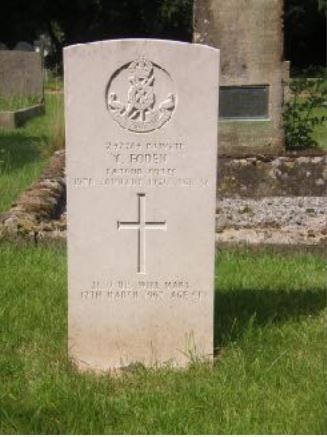542nd Home Service Employment Company, Labour Corps

Charles Foden attested for military service under ‘Lord Derby’s Scheme’, which was the bridge between voluntary enlistment and full conscription. He was initially posted to the Royal Garrison Artillery.
He was born in Moreton-in-Marsh in 1883, the son of Herbert Strettal Foden (1847-1889) and his wife Eliza (née White; 1846-1923). He was one of three children.
His father died when he was six years old and it would appear that his mother kept the family together by running a drapery and millinery business from their home in the High Street, Moreton-in-Marsh. At the time of the 1901 census Charles was an assistant within this business.
Ten years on he was still earning a living as a draper but now living on his own, apart from a male school teacher as a lodger.
Later in 1911 (on 21 August) he married Mary Ann Meade Lines (1876-1967) at Cardiff. The couple had three children, twin girls in 1913 and a son in 1917.
Fortunately an Army Service Record has survived for Charles, although some of the detail is difficult to decipher. Having attested for military service on 3 December 1915, almost certainly under ‘Lord Derby’s Scheme’, he was placed in the Reserve awaiting mobilisation. He presumably returned to his work as a draper in Moreton-in-Marsh until he was finally mobilised on 22 January 1917.
His initial posting was as a Gunner (number 136950) with the Royal Garrison Artillery (RGA). He was sent to Ireland and by June 1917 was serving in the Signal Department at Spike Island, Co. Cork (probably inside Fort Michel). He was evidently not the fittest of men as he was categorised as B3, suitable only to undertake sedentary duties. On 28 July 1917 he transferred to the Labour Corps and 542 Home Service Employment (HSE) Company and was given the number 242284. HSE companies undertook a wide range of administrative and support roles and one of these was a telephone operator: having worked in the Signals Section with the RGA maybe Charles undertook a similar role following his transfer. He was now located at Queenstown (now Cobh) in Co. Cork.
It would appear that almost all Charles’ military service was undertaken in Ireland, until he was discharged into the Reserve on 5 March 1919, due to bronchial catarrh, aggravated by military service. He was granted a 20% disability allowance for an initial period of a year.
He probably retuned to be a draper before he died on 15 January 1920, aged 37: his service papers state the cause of death was ‘lobar pneumonia’, a type of viral pneumonia.
Private Charles Foden was buried in Moreton-inMarsh Chapel Cemetery (now known as the New Cemetery), where a standard CWGC headstone now marks his grave. His funeral was reported in the Evesham Standard & West Midlands Observer of 24 January 1920 but this does not contain any details of his military service. He is commemorated on the Moreton-in-Marsh War Memorial.
Researched by Graham Adams 16 September 2020
